Best bike pumps 2025: Mini pumps and floor pumps reviewed and rated
Make dealing with flats out on the ride and tyre fitting at home a breeze using one of the best mini or track pumps
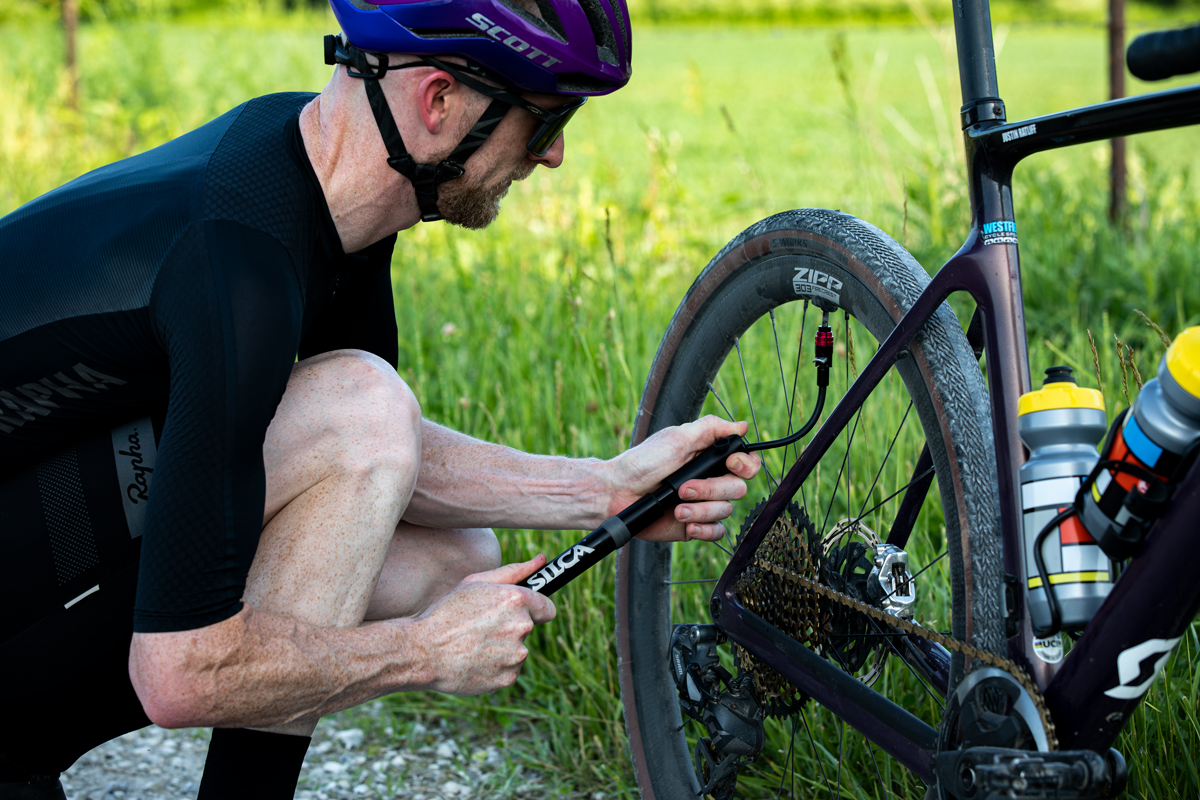
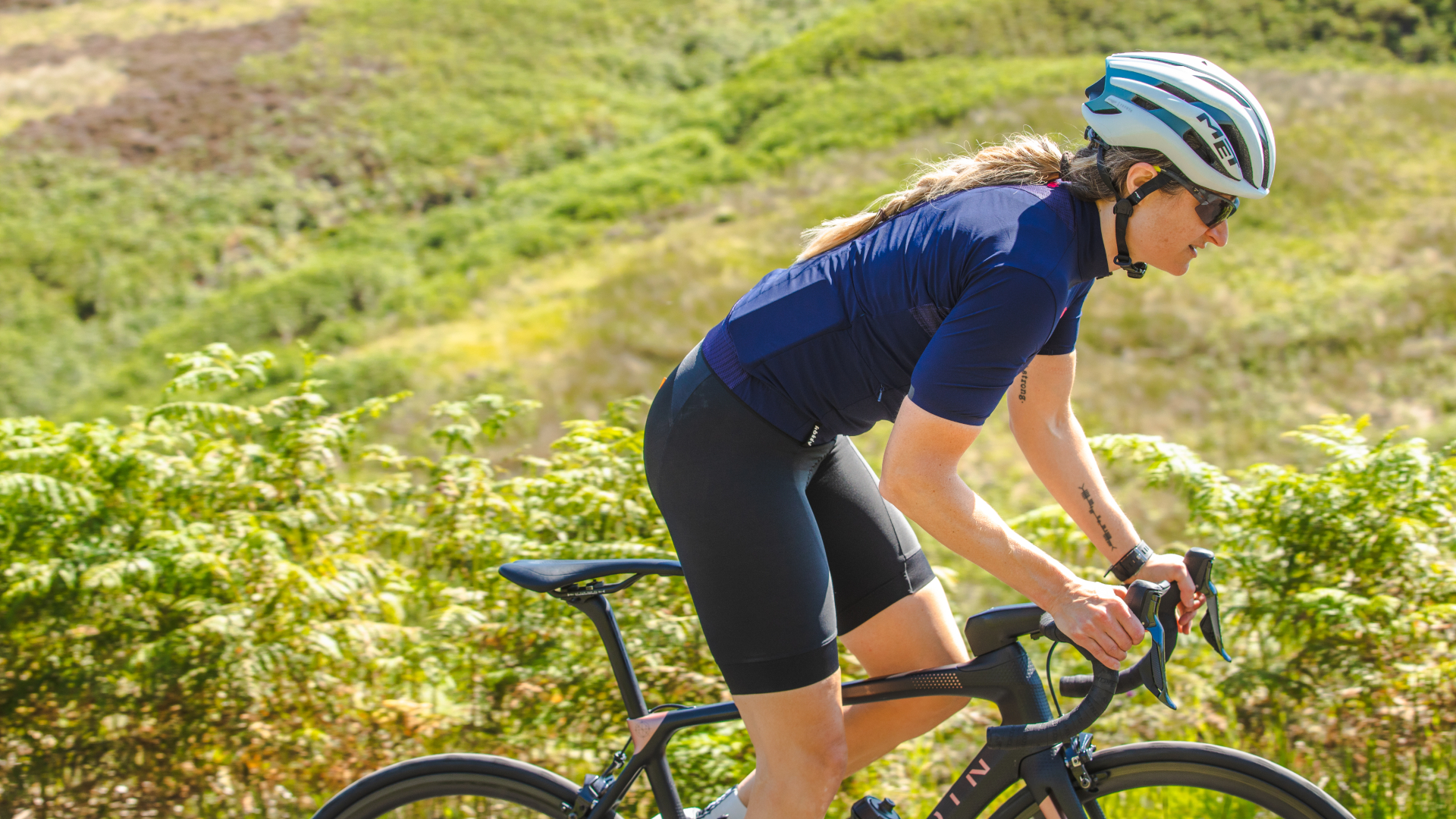
Your bike's only contact with the ground is a relatively small amount of tyre, so it's vital to ensure that it is inflated to the correct pressure every ride. Owning one of the best bike pumps will make tyre inflation much easier and quicker.
There are two main styles of pumps available for cyclists: hand or mini pumps, which you can carry with you on a ride in case of a puncture or loss of pressure, along with some of the best tyre levers and multi-tools; and floor pumps (also known as track pumps), which you can have at home when you require quick inflation, setting up some of the best road tubeless tyres or minimal effort in general.
To help you make it easier, I have divided this guide into two categories: one for the best mini bike pumps and the other for the floor pumps. Having tested dozens of pumps, we feature only the best and most highly rated pumps in this guide. For example, one of the best for quick inflation out on the road is the specialized air tool; it's a sleek pump that will have you back on pedalling in no time.
In an ideal world, every cyclist would own both a mini and a floor pump. We understand that pump ownership is quite an investment. So to help you decide which style of pump works best for you, scroll to the bottom of this buyer's guide for our helpful Q&A section.
The Quick List
The best mini bike pumps
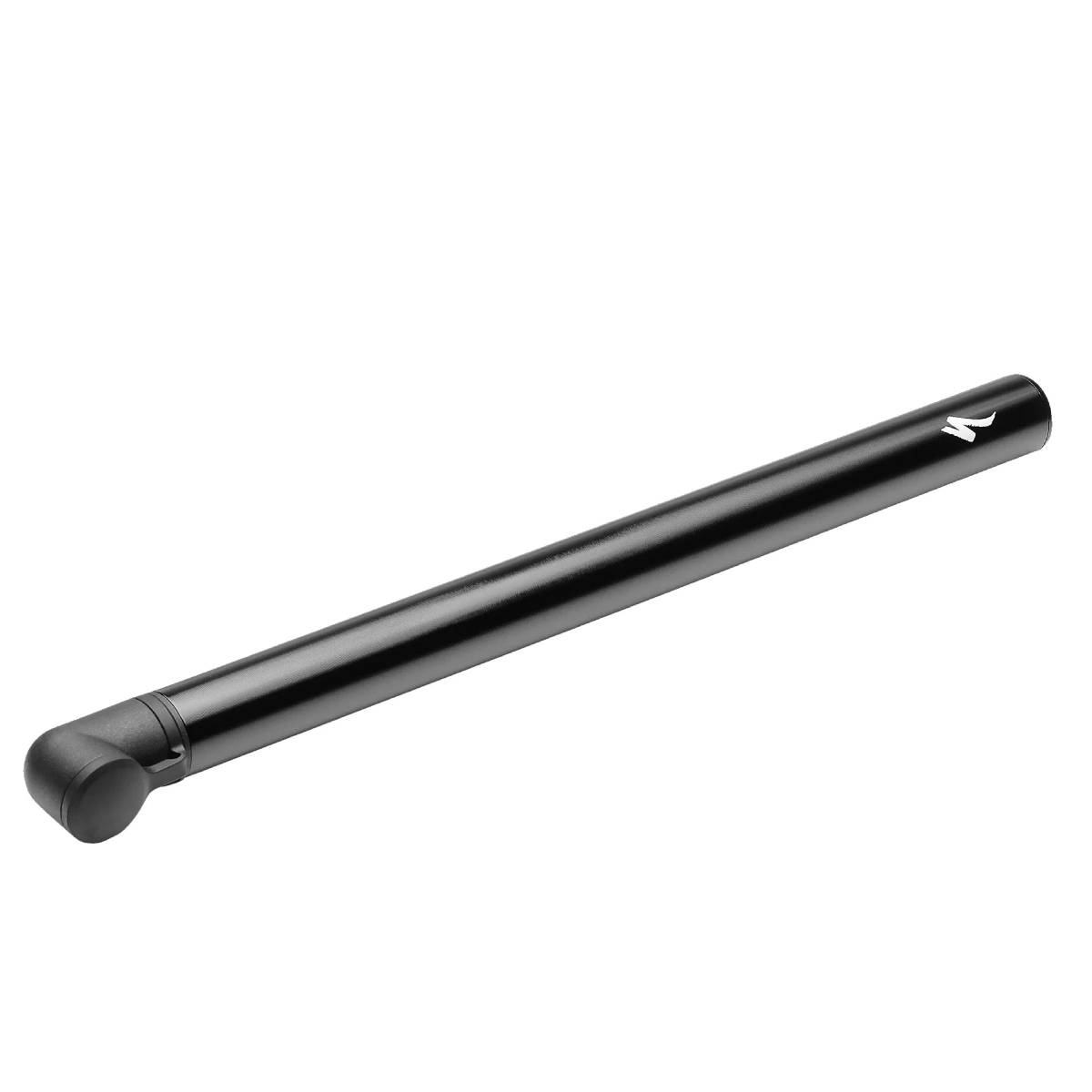
Best for quick inflation
Delivers plenty of volume per stroke. Lightweight, but too long to carry in your pocket so you'll need to use the frame mount.
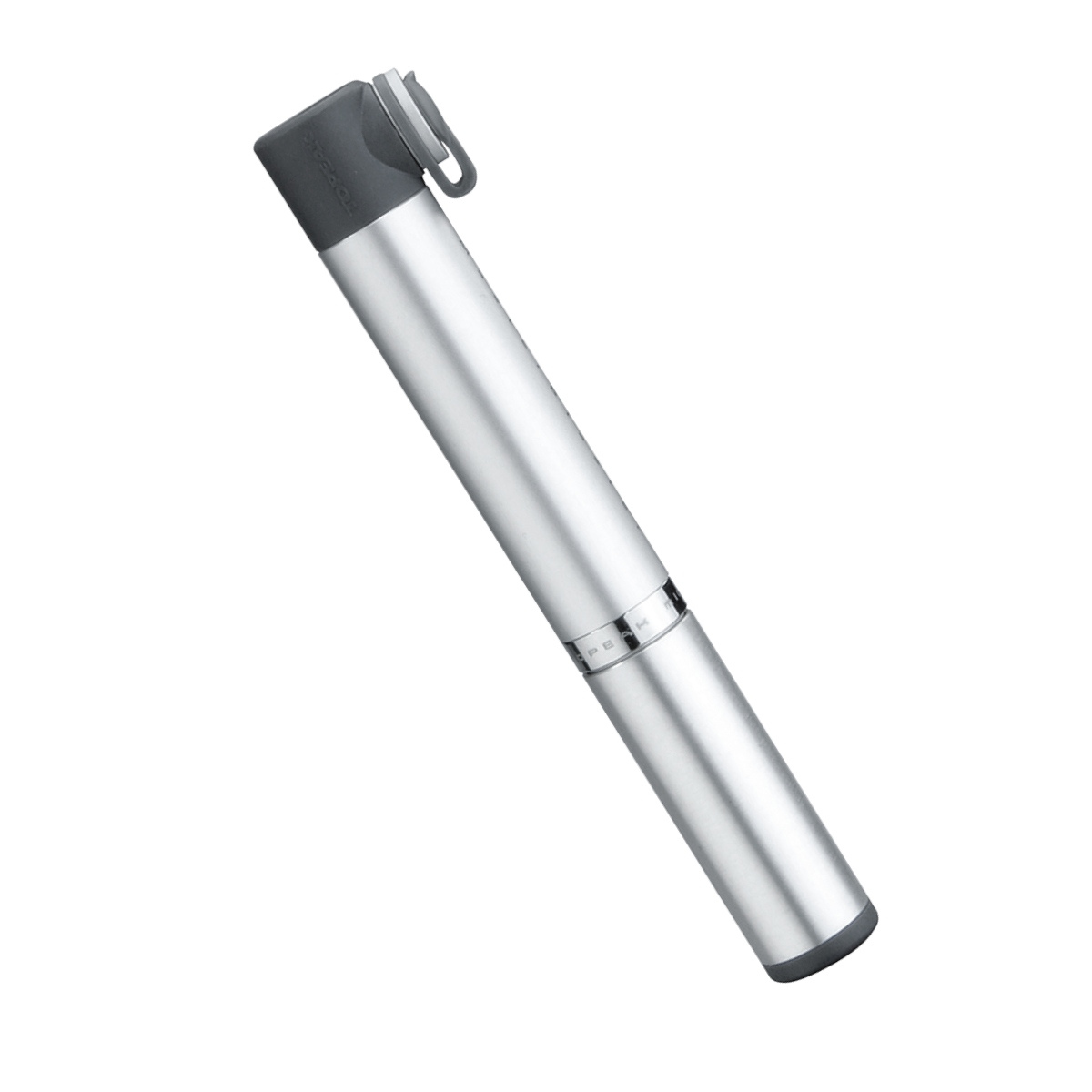
Easiest to stow
At just 160mm long and 65g, it might even be compact enough to fit in your saddlebag. Despite its size, it's comfortable to use.
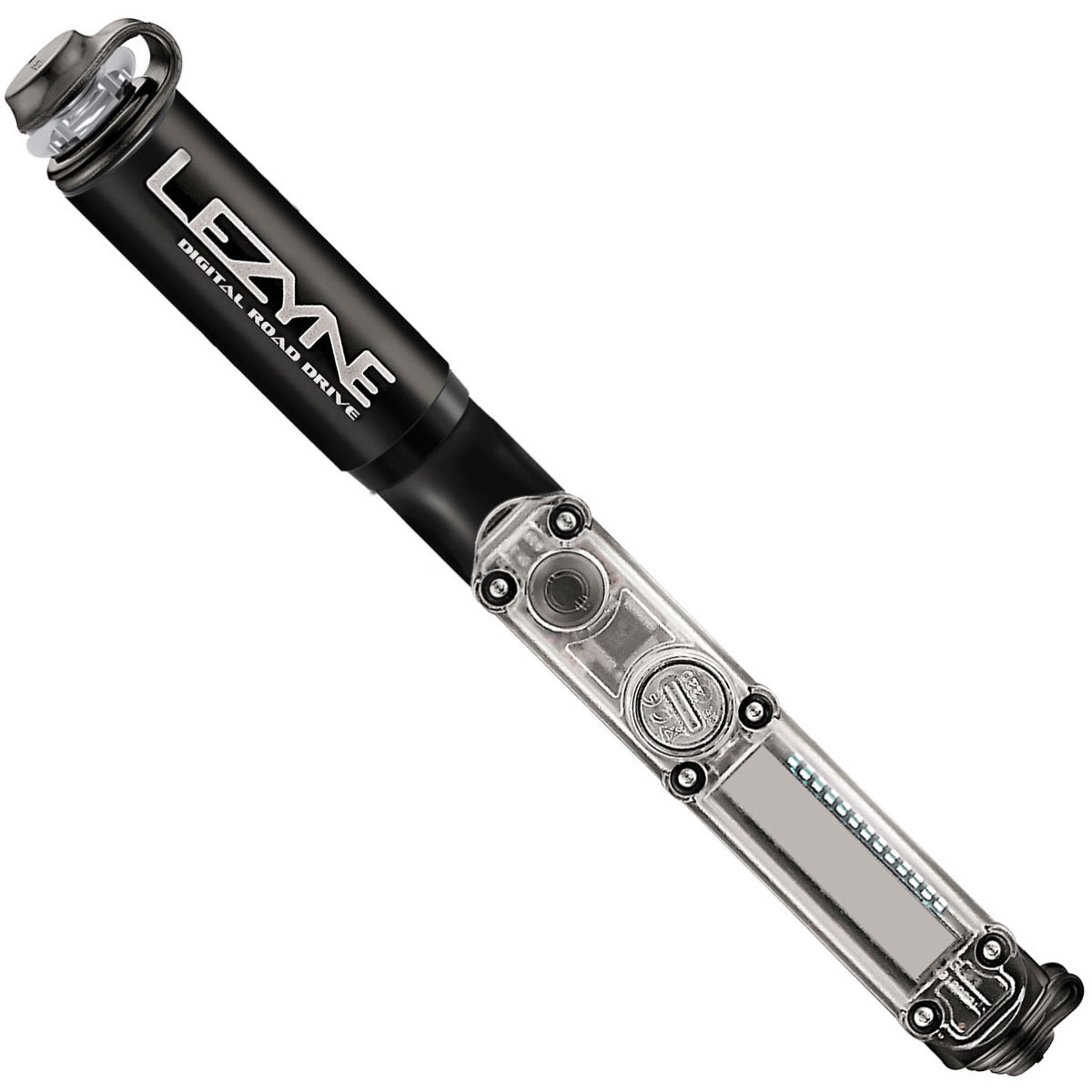
Best for pressure readings
Achieve an accurate digital tyre pressure reading from the swift and efficient Aluminium pump while out and about.
The best floor bike pumps
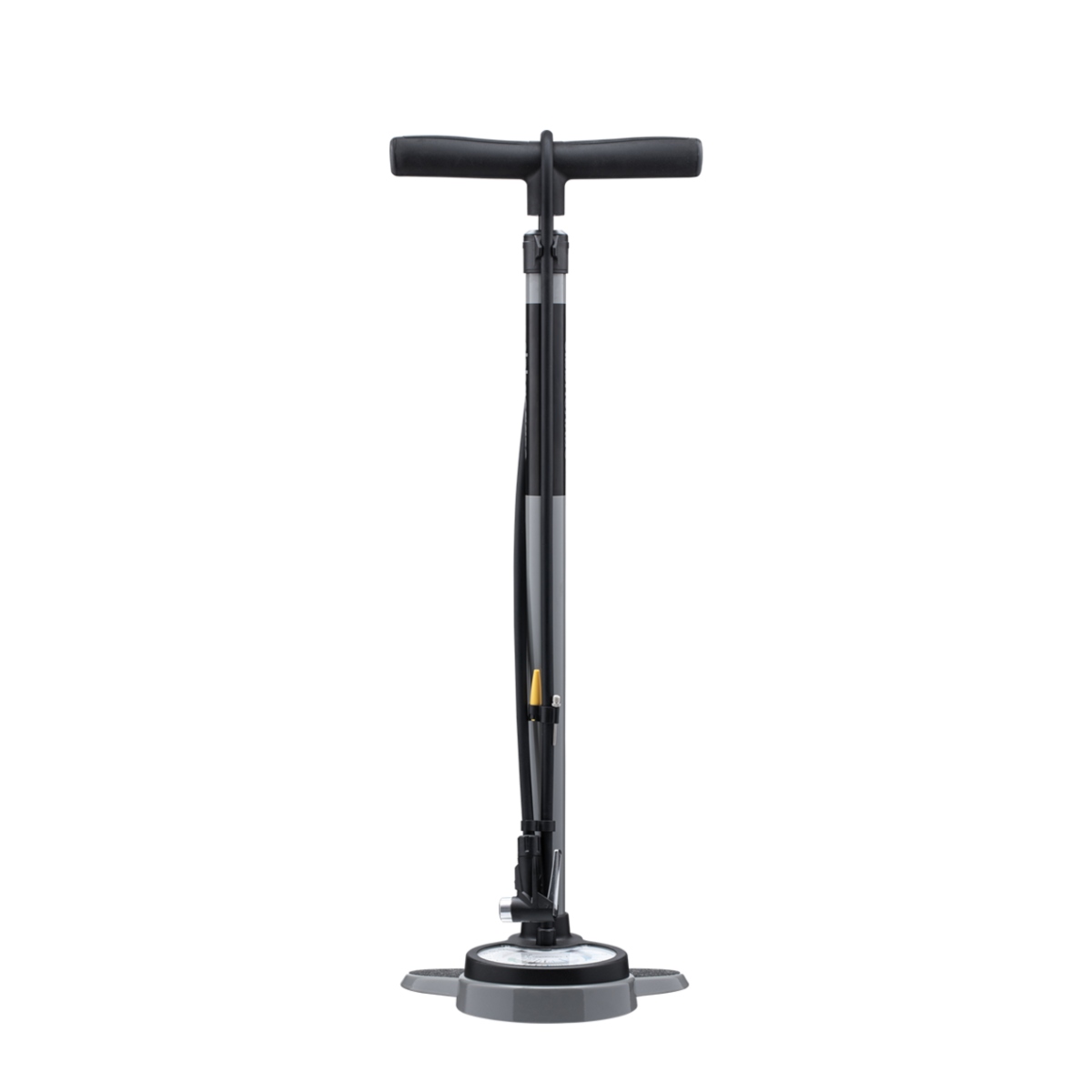
Best easy to read gauge
The large gauge is easy to read and accurate, while the pump as a whole is well put together and keenly priced.
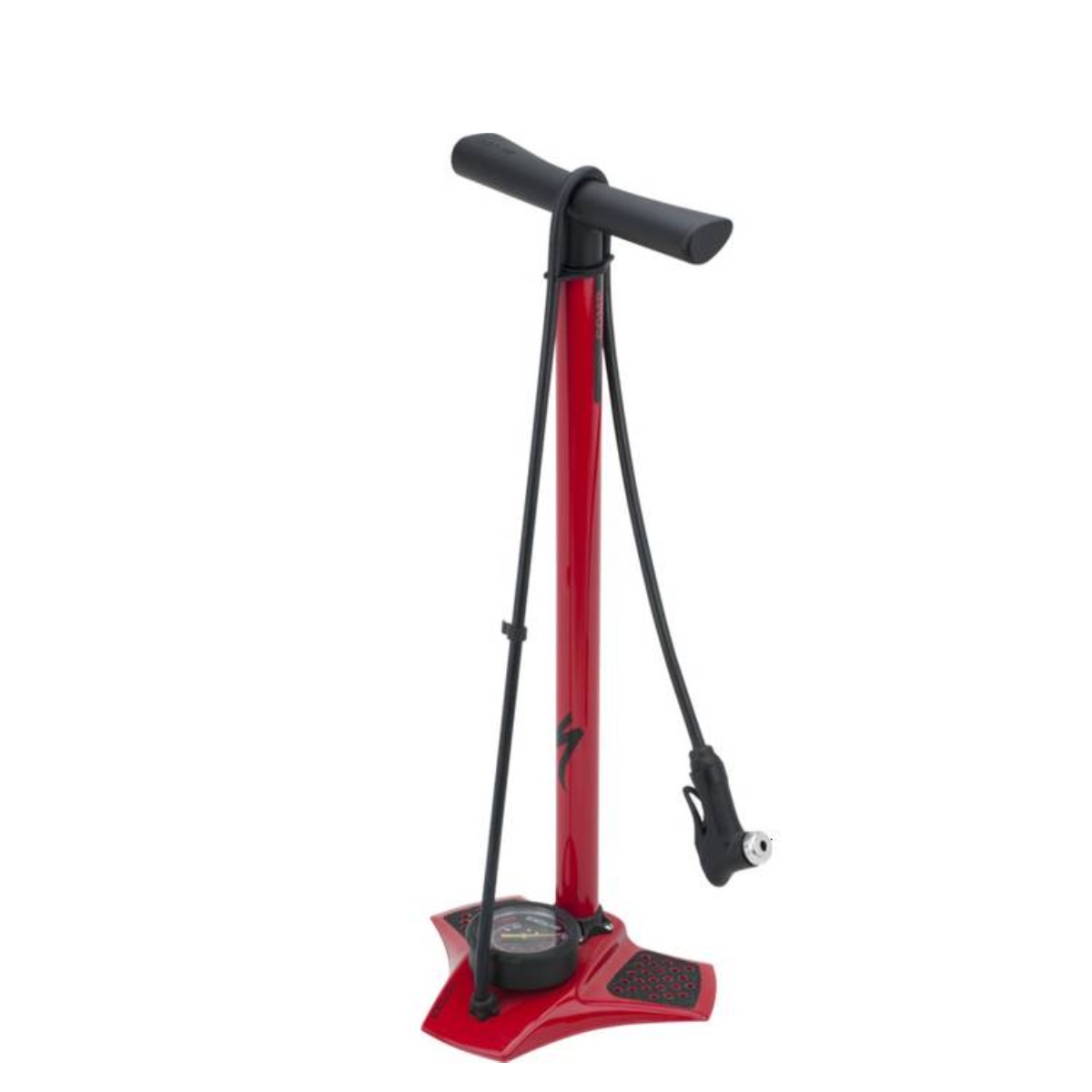
Best do all floor pump
The SwitchHitter head auto-adapts to the valve type, and the dual-scale gauge makes it easy to lower the pressure in gravel tires.
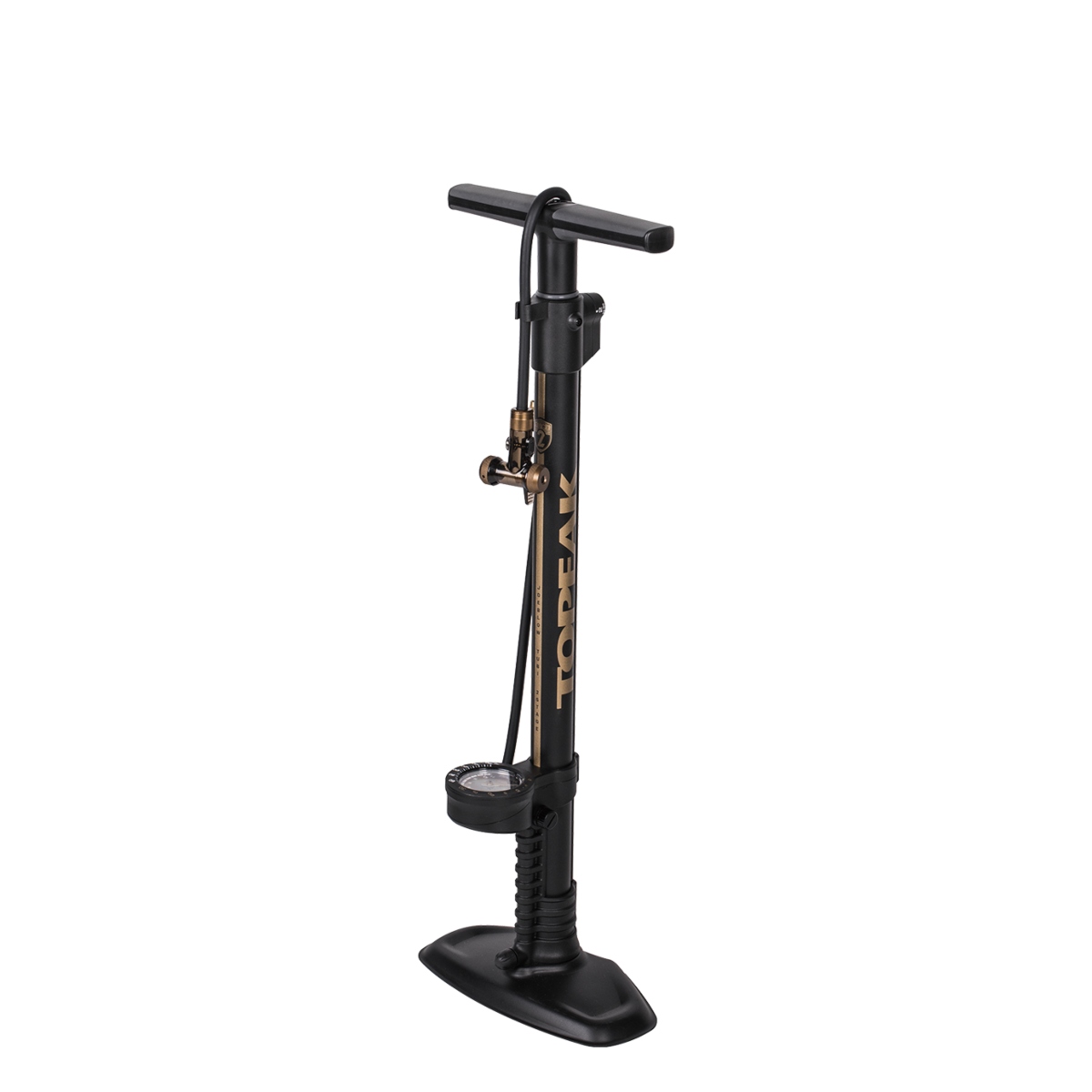
Best budget bike pump
Efficient and stable, the Max II track pump is a great wallet-friendly option from the Topeak JoeBlow range of bike pumps.
Best bike pumps: Mini pumps
Best for quick inflation
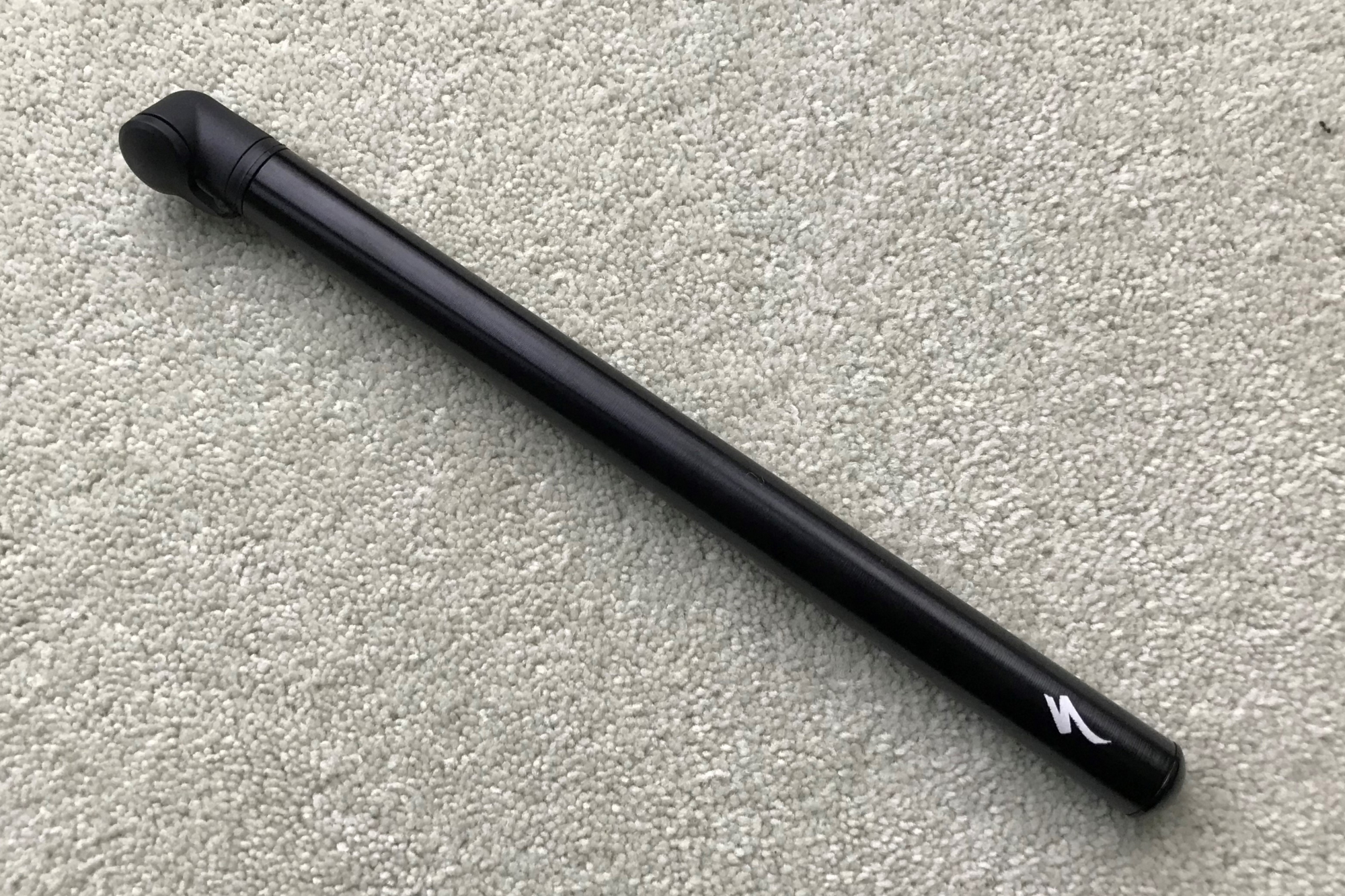
Specialized's Air Tool weighs under 100g and inflates tyres quickly
Specifications
Reasons to buy
Reasons to avoid
The design of the Specialized Air Tool Road centres around maximising the volume of air it delivers relative to its size, to make inflating your tyres as quick as possible.
It's lightweight (99g) but long so you'll need to make use of the frame mount to carry as it won't fit in your pocket.
We found that the head fits really snuggly over the valve but is limited to Presta valves only. During our testing we also felt that the minimalist design does make it a bit more tricky to hold firmly but once you've got your hands in position it's quick and easy to get more than enough air back in your tyres.
Read more: Specialized Air Tool Road mini pump full review
Easiest to stow
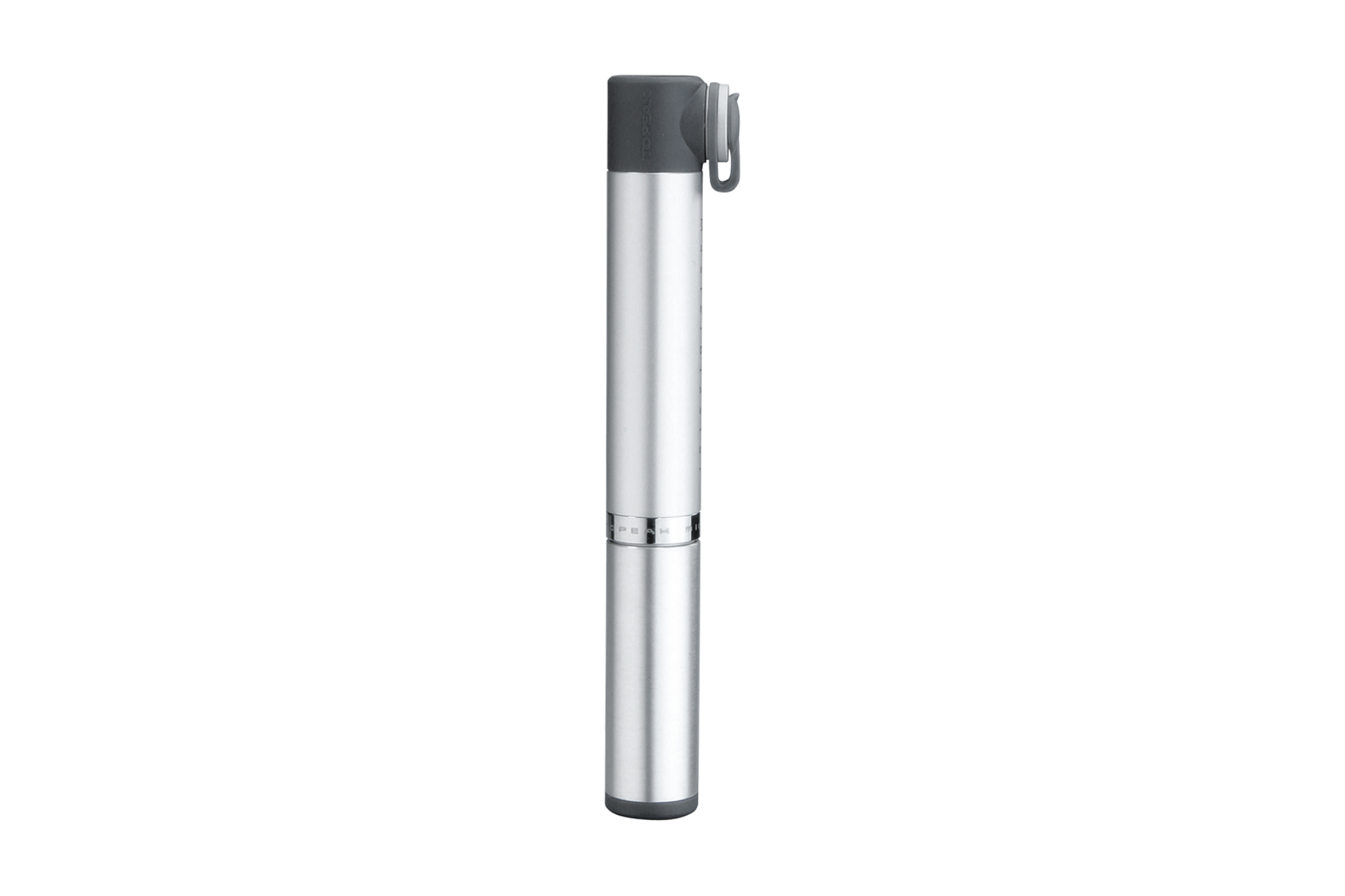
At just 65g Topeak's Microrocket AL is lightweight and easy to store
Specifications
Reasons to buy
Reasons to avoid
A light aluminium construction, this pump is connected directly to the valve, without the need for any assembly or an extra hose.
At just 160mm long and weighing only 65g, it is one of the smallest bike pumps on the market, and easy to fit in a jersey pocket or even a saddle bag. If you are already packed to the rafters, the mini pump even comes with a frame mounting kit for either side of the bottle cage, or an optional extra centreline mount (although check the brackets fit on your tubing shape before investing).
The claimed 160psi seems slightly ambitious, as on test 200 strokes only got us to just above 60psi on a 23mm tyre. It's more than enough to get you home or back to race HQ, but not as impressive as the Lezyne Carbon Drive Lite Mini pump, although to be fair it was comfortable in the hands when using.
Read more: Topeak Microrocket AL bike pump full review
Best for pressure readings
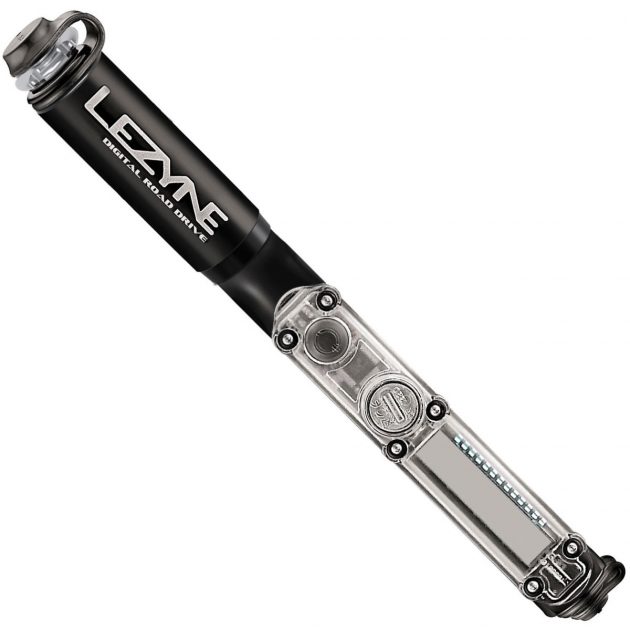
Lezyne's Digital Road drive features an easy-to-read gauge
Specifications
Reasons to buy
Reasons to avoid
A digital gauge on this mini pump from Lezyne will give you accurate tyre pressure measurements to a realistic and achievable maximum inflation capacity of 90psi, out in the middle of nowhere.
On test, we found that the hard-wearing aluminum pump was swift and efficient at reaching desired PSIs and, cross-checked with a regular gauge, accurate, too.
It is longer and heavier than some of the other bike pumps, especially the much-loved Lezyne Carbon Drive Lite Mini Pump, which has been discontinued. However, compared to the iPump Twist mini pump or Topeak Micro Rocket AL mini pump, it can still easily fit in a jersey pocket. Watch for losing the dust cap.
It's a great bike pump for several reasons. But if the price is putting you off, consider that it can potentially save you the additional expense of purchasing a pressure gauge.
Read more: Lezyne Digital Alloy Drive mini bike pump full review.
Best electric bike pump
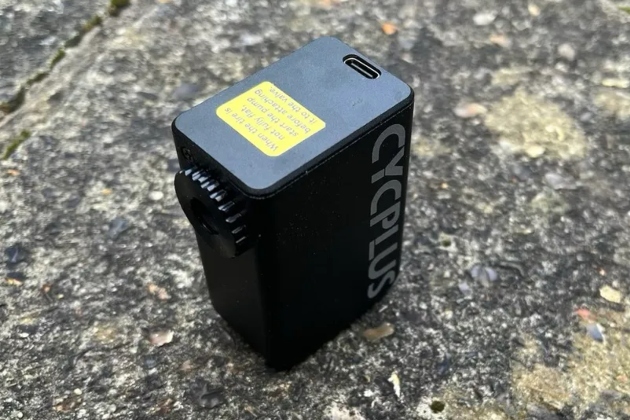
Cycplus Tiny E-Pump AS2
Specifications
Reasons to buy
Reasons to avoid
Something a little bit different - the Cycplus Cube Mini is a simple push-button on/off electric tyre inflator. Speedier than a conventional mini pump, and able to replace a brace of CO2 cartridges and recharged using its USB-C port.
Follow Cycplus's guide timings to reach the desired pressure. On review, we found them accurate. The pump can also handle larger-volume tyres; you just need to leave it running a little longer.
Switching the head from Schrader to Presta can be a bit fiddly, especially since 90 percent of cyclists use that valve fitting. Otherwise, it is a good little tool as long as you're happy with limited attempts to fix that puncture. If you already use CO2, that shouldn't be a problem. If you're risk-averse, then maybe a mini pump is the safer bet, even if you'll be there pumping away for longer than 90 seconds, plus you won't need to worry about when you last charged it!
Read more: Cycplus Cube Mini
Best bike pumps: Floor pumps
Best easy to read gauge
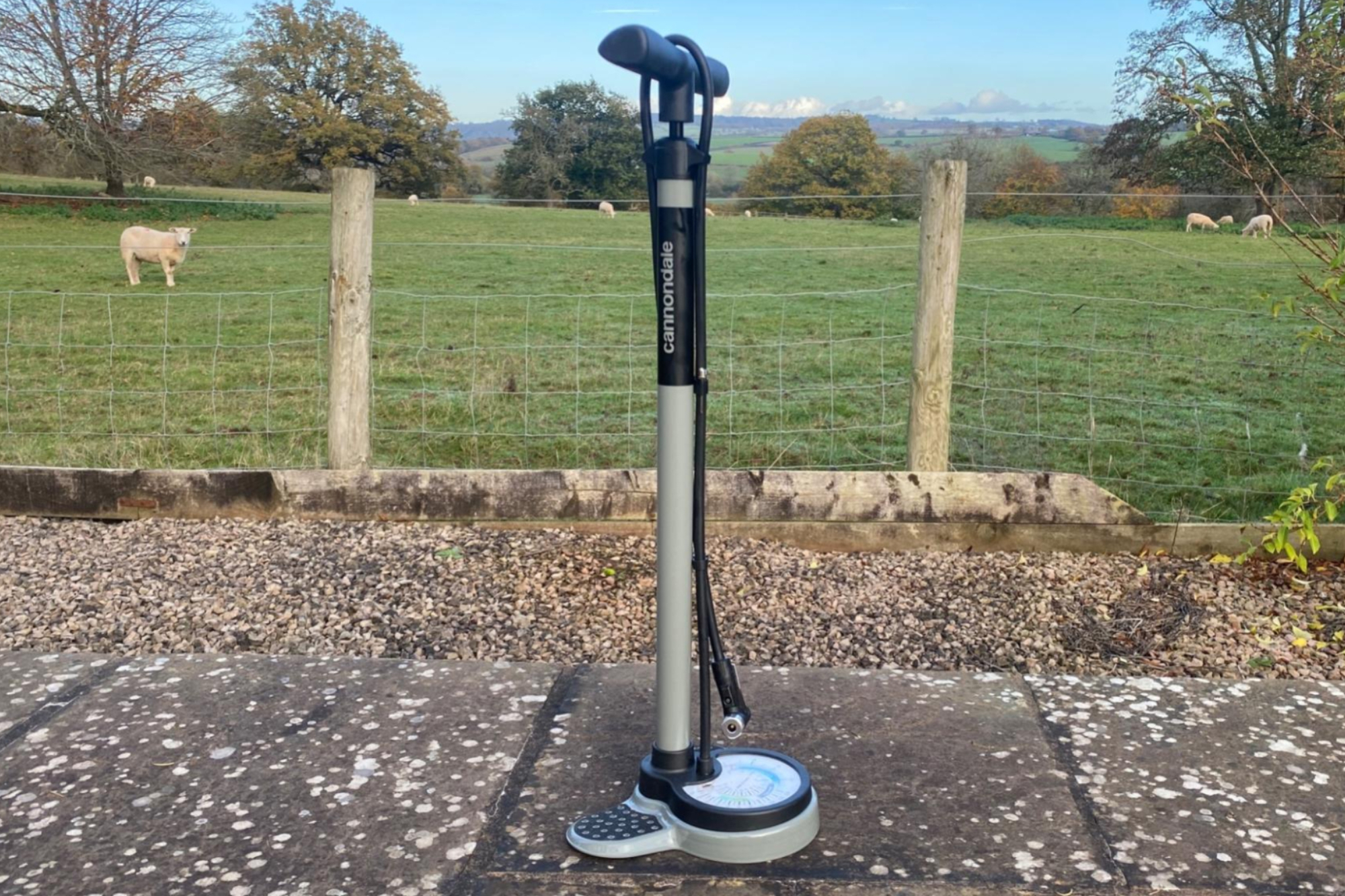
Cannondale's Precise Floor Pump boasts a large, easy-to-read gauge
Specifications
Reasons to buy
Reasons to avoid
Cannondale’s Precise Floor pump is a very effective and powerful floor pump, thanks to its large shaft and long stroke allowing for a large volume of air to be delivered per pump. It can pump 25mm tyres up to pressure in 20 pumps, rather than the 30 it took for a competitor pump at a similar price point. We also found enough air was delivered to seat tubeless tyres on occasion.
The pump's big selling point is its large pressure gauge, which is significantly larger than that of competitors. This scale is enlarged for the first 40 PSI so that you can be very precise with larger-volume tyres that require lower PSIs. The scale then goes up to 145 PSI, which is possibly not enough for track riders but more than enough for most cyclists.
Value-wise, the Precise Floor pump is pretty good. It performs better than other similarly priced pumps and is as good as or better than more expensive ones. Although it is not made of fancy, shiny materials like some more expensive options, it is rugged and effective. Overall, it is a great track pump and well worth the investment.
Read more: Cannondale Precise Floor Pump full review
Product focus - Best for tubeless set-up
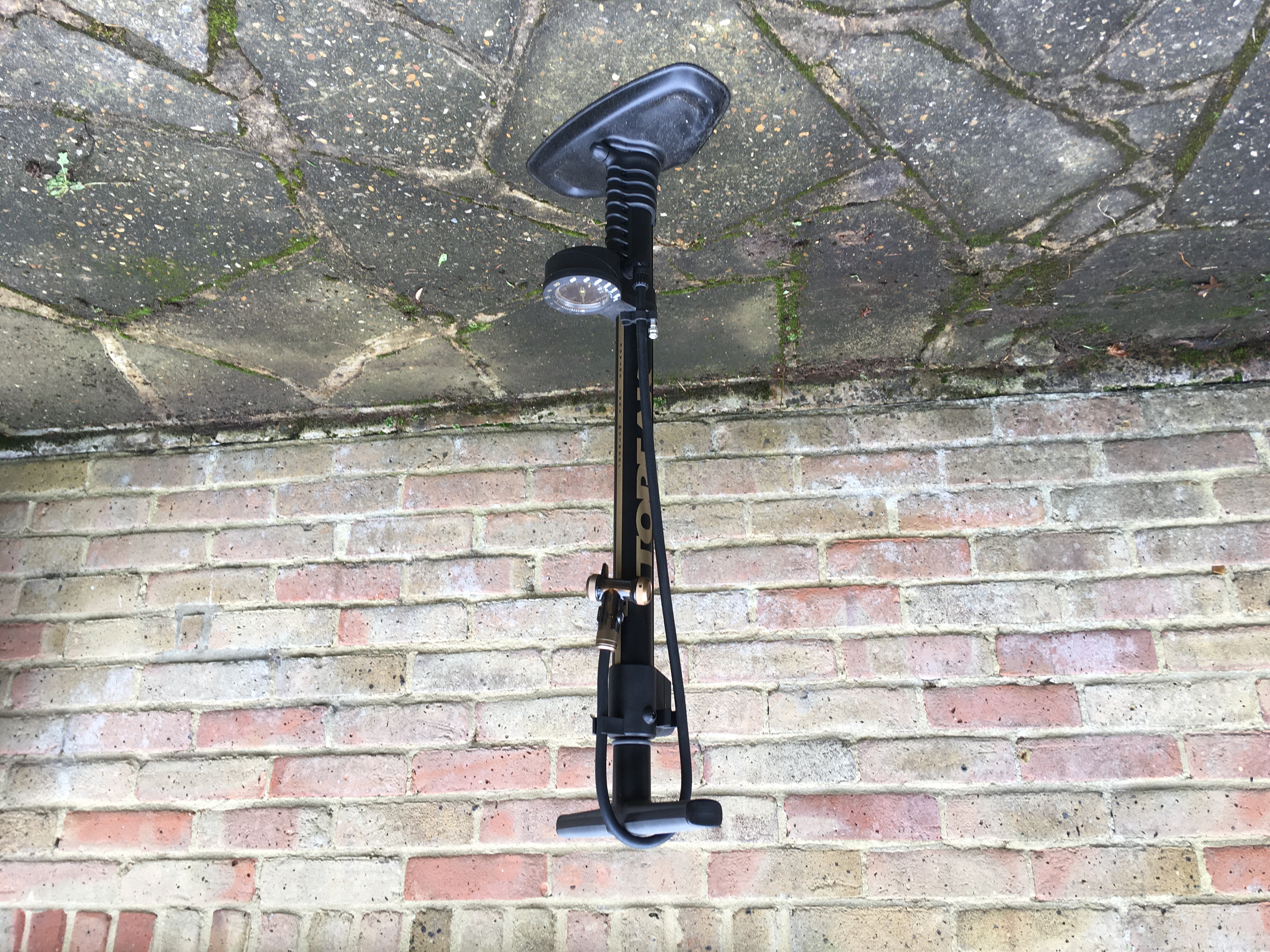
Topeak JoeBlow TUBI 2-Stage
The Tubi 2Stage pump incorporates a knurled knob to remove a Presta valve core so that you can get more air into a tubeless tyre more quickly, promoting seating. That's Stage 1. You can then refit the core and flip a switch to get things up to operating pressure using Stage 2. There's an adapter if you want to pump Schrader valved tubes.
Best do-all floor pump
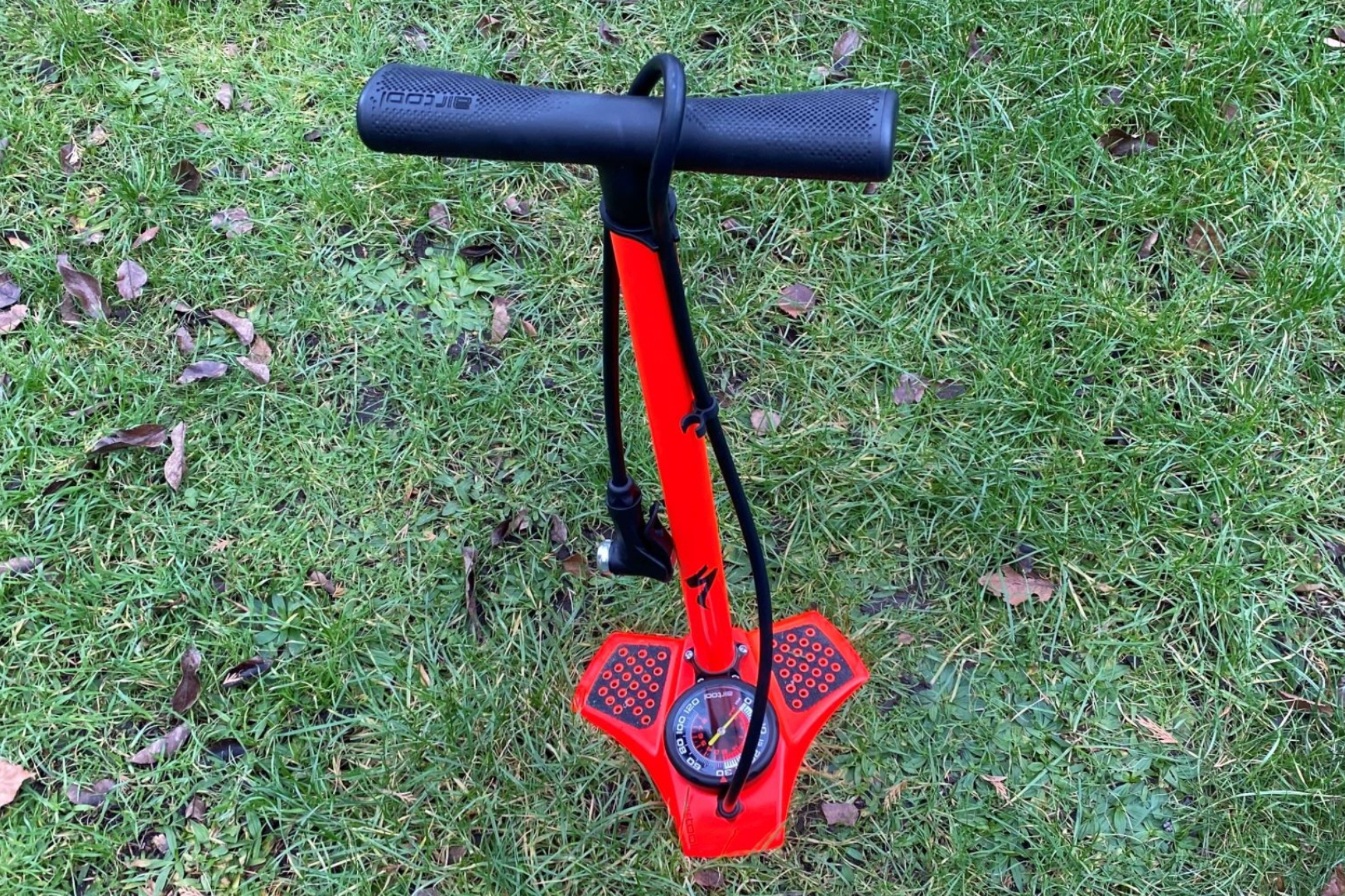
The Air Tool Comp's head automatically adapts to the valve type
Specifications
Reasons to buy
Reasons to avoid
Having a flat or changing tyres is one of the simpler but probably most frustrating jobs for the home mechanic. The range of different volumes and pressures of tyres and more than one valve type can all add to this.
The Specialized Air Tool Comp Floor Pump isn't going to inflate your tyres for you, but it does do a pretty good job of minimising the fuss regardless of your valve, tyre pressure and volume.
The SwitchHitter II head automatically adapts to Presta and Schrader valves taking away any fiddling or even remembering which one is which. The Air Tool has a max pressure of 120psi which is easy to achieve and the dual-scale gauge makes it simple to get lower pressure in gravel tyres too.
Read more: Specialized Air Tool Comp Floor Pump full review
Product focus - Rapid inflation
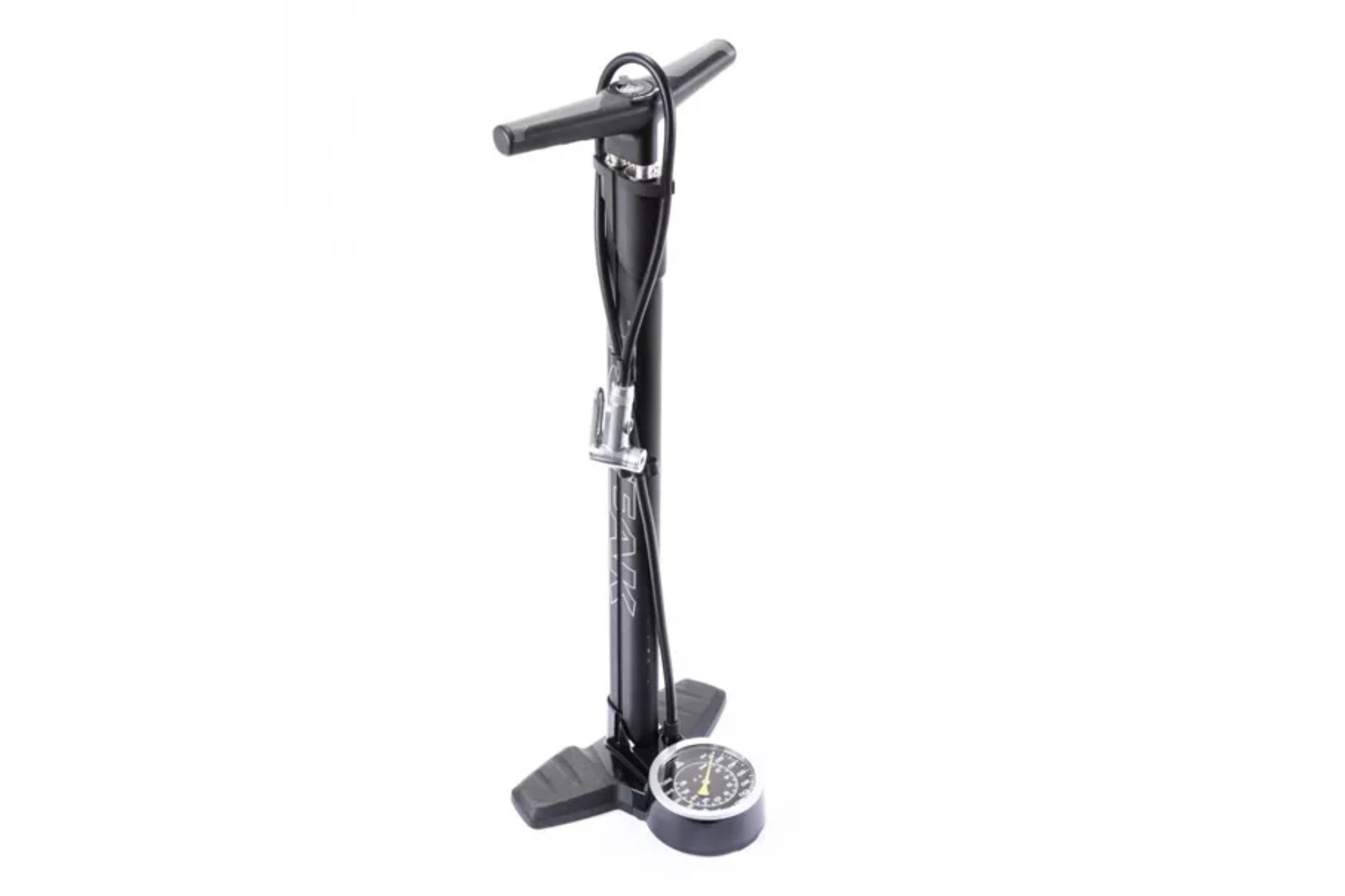
Topeak JoeBlow Ace DX
If rapid inflation is a requirement, then the Topeak JoeBlow Ace DX towers over many other pumps not only in height but also in capability. In its '60' setting, the Ace DX inflated our test 700x25c tubeless tyre to 100psi in 11 monster strokes, making it the best bike floor pump for swiftly inflating your tyre.
Read more: Topeak JoeBlow Ace DX bike pump full review
Best on a budget
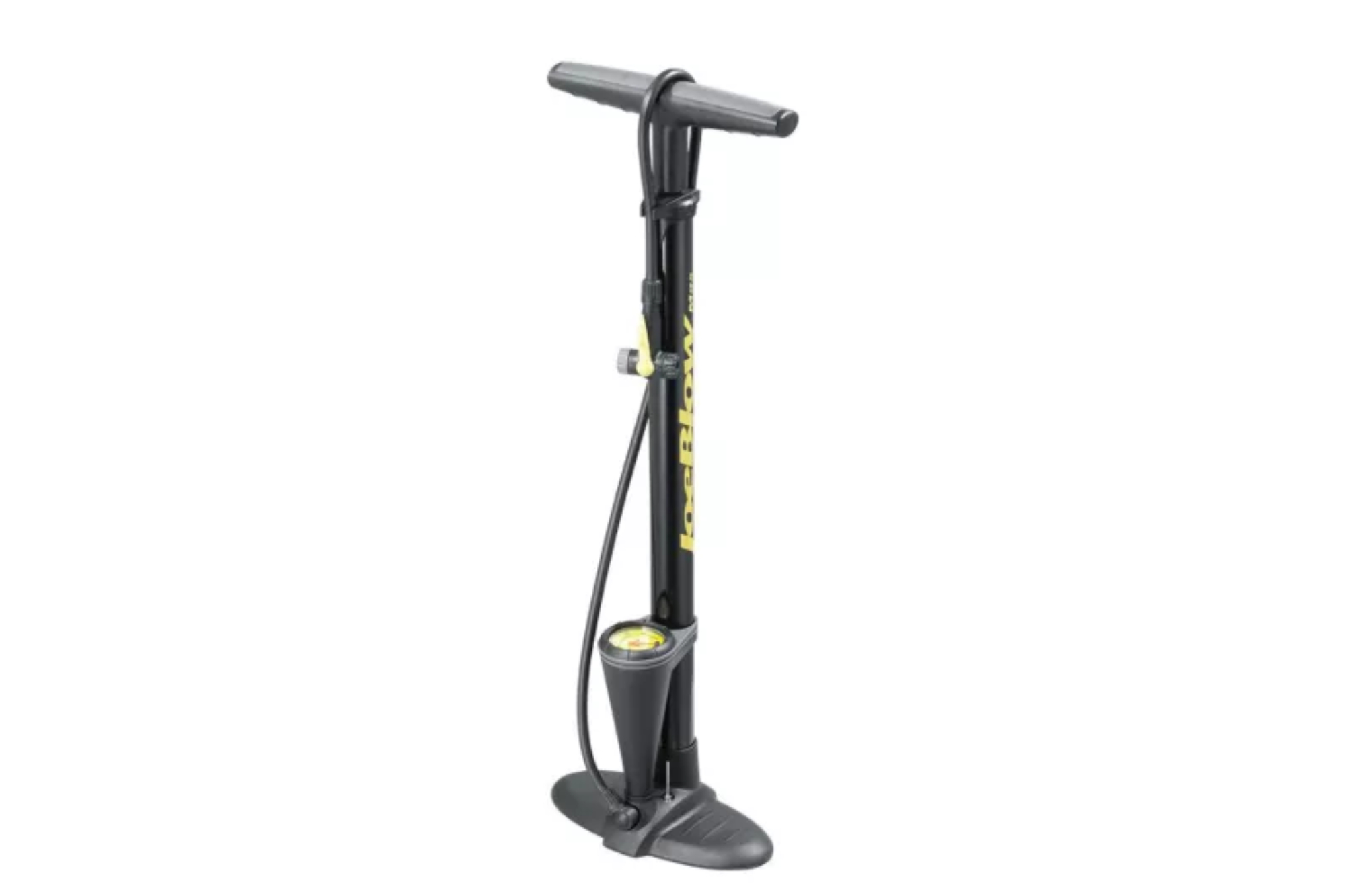
A wallet friendly price tag makes the JoeBlow Max II a reliable choice for cyclists on a budget
Specifications
Reasons to buy
Reasons to avoid
If you're looking for something a little less pricey than the dual-compatible pro-home Topeak Joeblow Booster floor pump, then this is the one. Finished with a steel barrel and a quality gauge, the JoeBlow Max II track pump is a great bike floor pump that meets all your basic needs, but limiting its extra functionality keeps the cost down.
On test we found that it took just 19 strokes to get a 23mm tyre up to 100psi, which makes it a very efficient pump.
The pump comes with a plastic twin-sided head that works with both Presta and Schrader valves and has a lever to lock it onto the valve securely.
There are even replacement parts available should anything stop working, making it a good long-term choice too.
Read more: Topeak JoeBlow Max II bike pump full review
Best for large volume tyres
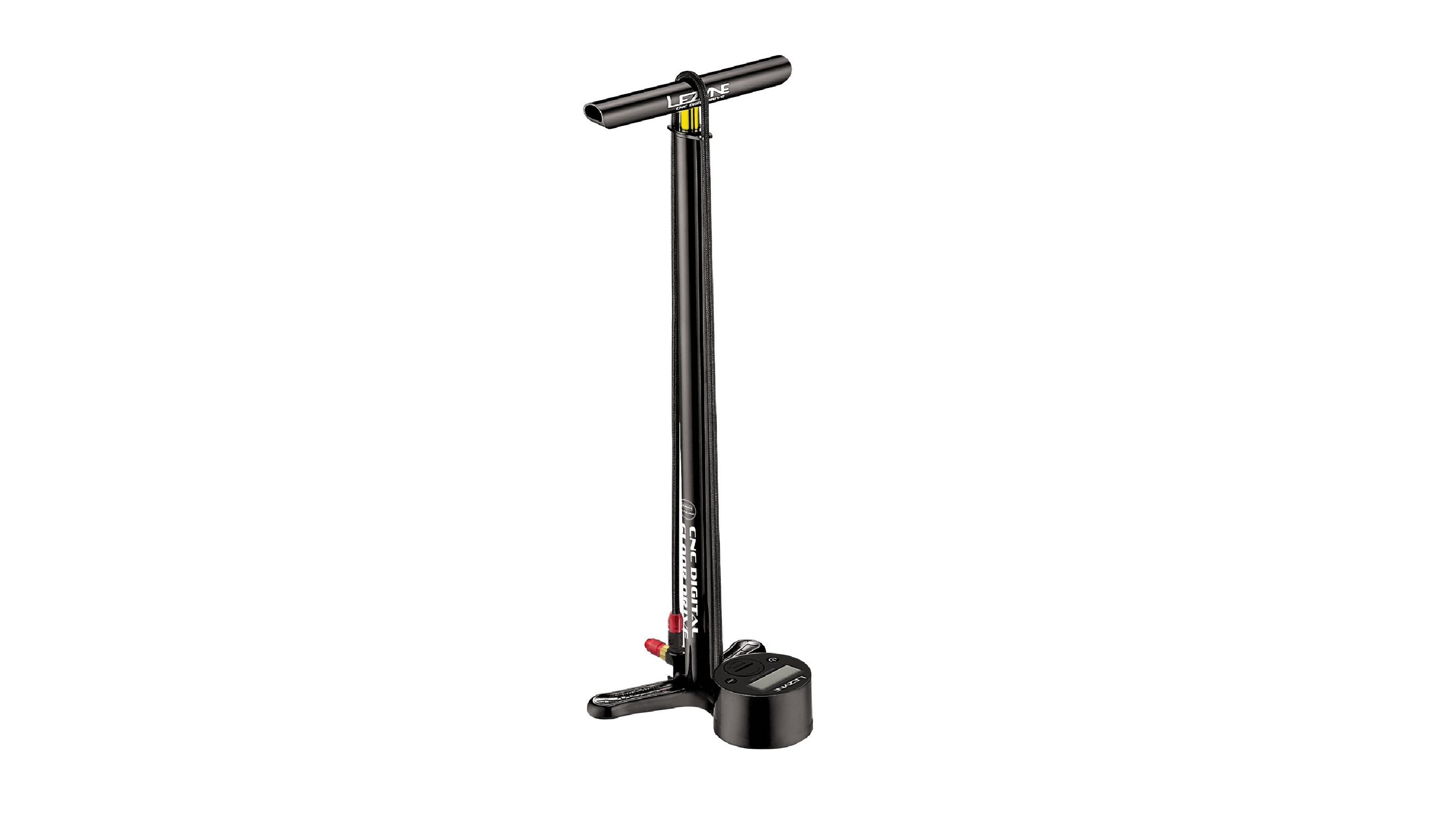
Lezyne's Gravel Digital Drive Pro delivers a high volume per stroke ratio making it well-suited to wide gravel tyres
Specifications
Reasons to buy
Reasons to avoid
An Editor's Choice pick, Lezyne's gravel tyre pump adds more air per stroke than road-oriented pumps, so it's good for higher volume tyres and may help achieve easier seating of tubeless tyres as well. It's made of aluminium and there's even an integrated valve core tool.
The digital pressure gauge means that you can get precisely the pressure you need for off-road riding, where getting it just right, even down to the nearest 0.5psi, is more important than with road bike tyres. Although designed for gravel tyres, the 100psi maximum rating means that it's more than adequate for most road bike tyres as well.
Read more: Lezyne Gravel Digital Drive Pro bike pump full review
Buyer's guide to the best bike pumps
How do I choose a bike pump? Mini pumps versus floor pumps
Fundamentally there are three different ways to inflate your bike tyres. We have lots of detailed information below, but as a quick summary:
Mini pump - The best portable bike pump will balance the ability to inflate your rubber and being small enough to carry in your rear pocket or stow on the frame. Your riding priorities will help you focus your decision here as, like all bike pumps, each one will lean towards a specific talent, eg micro size and weight, but not great at achieving much more than getting you home tyre pressure, or great PSI capabilities but heavier and frame mounted.
Floor pump (aka track pump) - In the main, this is a stay-home pump and the best way to achieve higher pressures, especially when going from totally flat. Most will include a pressure gauge so you can make sure your tyres are properly inflated before heading out for your ride. Some floor pumps include an 'air chamber' which can be pumped to high pressures in order to seat tubeless tyres. You may see them called reservoir pumps.
CO2 Inflator - Technically this isn't a pump as it contains compressed gas, which can reach up to 120psi in seconds. There are pros and cons to this system, more of which is explained in detail on our page dedicated to the best CO2 inflators.
What is a mini bike pump?
A mini pump is a small, portable pump designed to be carried with you on your rides. Sizes do vary - some are small enough to fit in a pocket or saddle bag whilst others might need to be frame-mounted. This portability comes at a cost though, and they are not the most efficient way to inflate a tyre so are primarily for emergency use if you suffer a puncture away from home. A good mini pump should be able to inflate a road tyre to 50 or 60 psi (enough to get you home) without too much trauma but be prepared to be pumping for a while as their diminutive size means that not much air is being moved with each stroke. Typically, a mini pump will take several hundred strokes to reach a reasonable pressure.
Some mini pumps attach directly to the valve whilst others include a hose to make life a bit easier, and most will work with both Presta and Schrader valves by swapping the head about. Integrated pressure gauges are definitely not an essential element of a mini pump, although some do include them, so don’t worry if a pump doesn’t have one.
How to choose the best mini bike pump?
Size, weight and efficiency are the three main elements to consider, along with your particular use case.
Racers and riders who don't venture too far from home will probably opt for the smallest pump available as they don't expect to have to use it much. Bikepackers and long-distance tourers, on the other hand, might prefer to sacrifice some compactness for greater efficiency and ease of use as it's more likely that the pump will see some action and less likely that there will be a convenient bike shop or taxi around if the worst happens.
What is a bike floor pump?
You don’t have to inflate many tyres with a mini pump before you realise that a track pump is a necessity, not a luxury. With far larger chambers two-handed handles and a stable base, a track pump will inflate a tyre in a fraction of the time that a mini pump takes. Furthermore, as you can use your bodyweight to lean on the pump, each stroke is far easier and more efficient too.
Usually, a track pump will have a long hose with a double-ended head that works with Schrader and Presta valves without the need to swap any fiddly parts and a sturdy foot plate to stand on for better stability. It will probably have a pressure gauge, so riders who like to fine-tune their set-up to the conditions(CX racers for example) have a better idea of how much air is in the tyre. The accuracy of these integrated gauges can be a bit questionable though on some pumps, so a separate digital pressure gauge is better if it really matters.
More recently, as tubeless tyres have become popular, some track pumps also include a separate, second chamber that can be pressurised and used to pop the tyre onto the rim initially.
What is the best bike floor pump?
Most track pumps will do the job adequately, but there are certain features that might appeal to you more than others.
Make sure that you get the right style of pump - large bore pumps are better at inflating bigger gravel and MTB tyres whilst pumps with a narrower bore are easier to use on high-pressure road tyres. If you use tubeless tyres then you might want to look at the type of pump that includes a second chamber that is designed to open the tyre onto the rim easily whilst if exact tyre pressure is important to you then an accurate, easy-to-read gauge is essential.
Do I need a mini bike pump if I have CO2 cartridges?
It is sound advice to always carry a mini pump with you, even if you also carry and use CO2 cartridges. Most experienced cyclists have experienced the frustration of a double puncture, induced by a nasty pothole or freshly cut hedge, and a CO2 cartridge can only pump up one tyre. It can also be very easy to not attach your inflator correctly to the valve, and lose all the CO2 without getting any in your tyre.
If you are striving for a KOM or personal record and are sure that back-up is available, then by all means ride with just CO2, but when some of the pumps on test weigh a scant 65g we would suggest that it is always worth sticking one in your pocket.
It is also less wasteful and cheaper to use a pump in the long run.
How should I carry my mini pump?
Most mini pumps come with clips to attach the pump to the frame, or, if it is small enough then the pump can go in a pocket, saddlebag or tool tub.
Carrying it in a pocket is the simplest solution, but it takes up space, might get forgotten and can get wet/dirty, particularly off-road. Similarly, if you use the bottle cage mounts, the pump will be exposed to all the spray and mud from the road or trail which might cause damage in the long term, but as it is on the bike it won't get left at home and is easy to get to. If you do use on-frame mounts, then it's worth ensuring that the pump's head is turned away from the direction any muck is likely to come from so it stays clean.
This leaves my personal preference, which is to keep the pump in a saddle bag or tool tub - out of harm's way but accessible and always with the bike. This option does require a pump that is small enough or a bag that is big enough to make this work.
How we test
We have a dedicated team of testers here at Cycling Weekly, whose job is to review a whole range of cycling products and to write objective reviews of their experience of using them day in day out in a whole range of conditions.
With huge experience, they're really well placed to compare products, identify their strengths and weaknesses and bring you an honest, unbiased assessment of how they perform.
When it comes to cycling pumps we've tested them for an extended period period of time to best assess their performance. For both track pumps and mini pumps we've looked at a number of factors including the stroke volume, the chuck design and the general ease of use. For mini-pumps we've also factored in their weight, how easy they are to carry on a ride and just how efficiently they'll help you get back on the road.
Get The Leadout Newsletter
The latest race content, interviews, features, reviews and expert buying guides, direct to your inbox!
Hannah is Cycling Weekly’s longest-serving tech writer, having started with the magazine back in 2011. She has covered all things technical for both print and digital over multiple seasons representing CW at spring Classics, and Grand Tours and all races in between.
Hannah was a successful road and track racer herself, competing in UCI races all over Europe as well as in China, Pakistan and New Zealand.
For fun, she's ridden LEJOG unaided, a lap of Majorca in a day, won a 24-hour mountain bike race and tackled famous mountain passes in the French Alps, Pyrenees, Dolomites and Himalayas.
She lives just outside the Peak District National Park near Manchester UK with her partner, daughter and a small but beautifully formed bike collection.
-
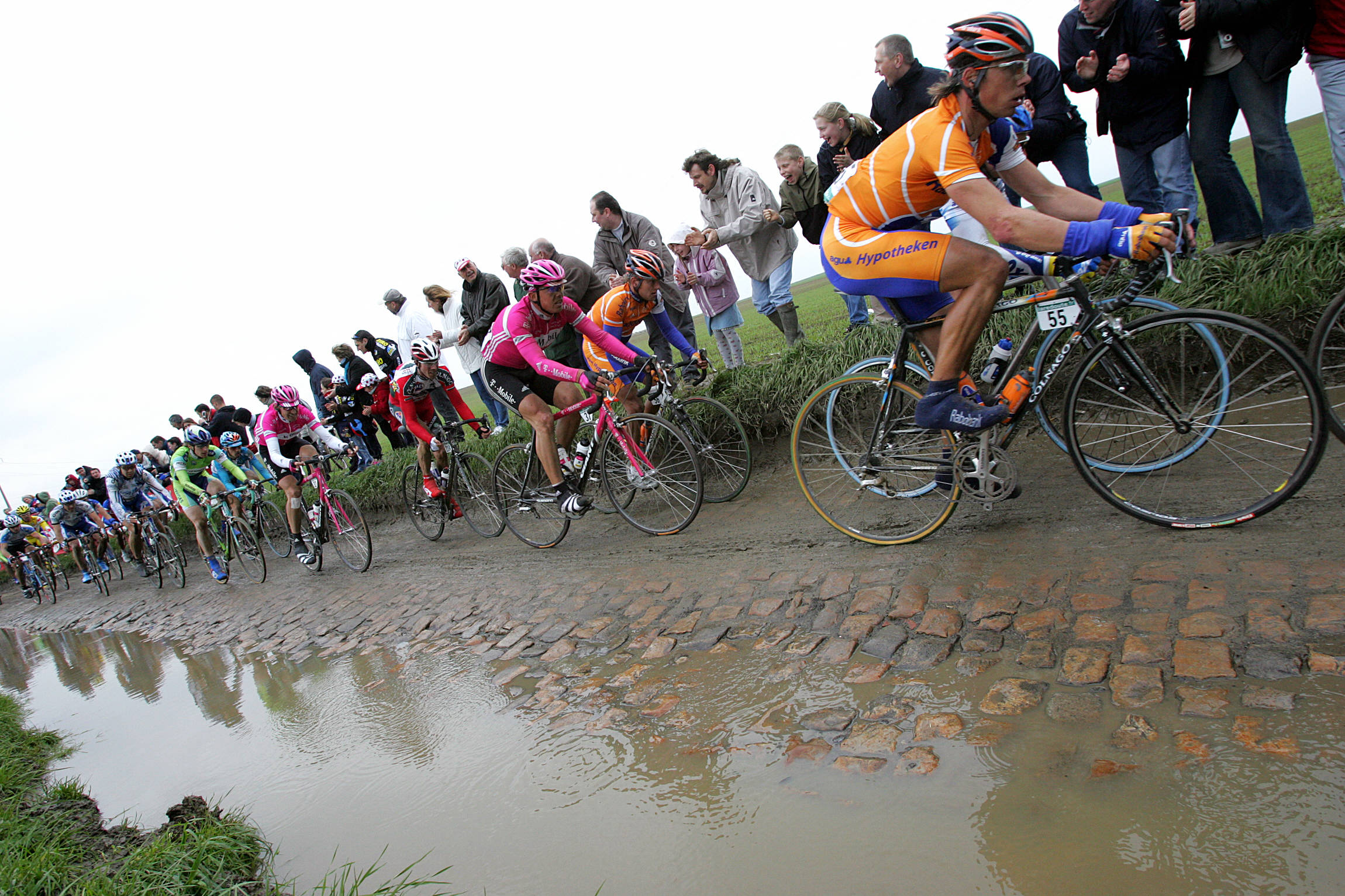 'I hope it rains... there's little room for error' - British cycling legend on the prospect of a wet Paris-Roubaix
'I hope it rains... there's little room for error' - British cycling legend on the prospect of a wet Paris-RoubaixSean Yates says that inclement weather won't stop the favourites from winning Roubaix, but that it'll add a bit more excitement
By Adam Becket Published
-
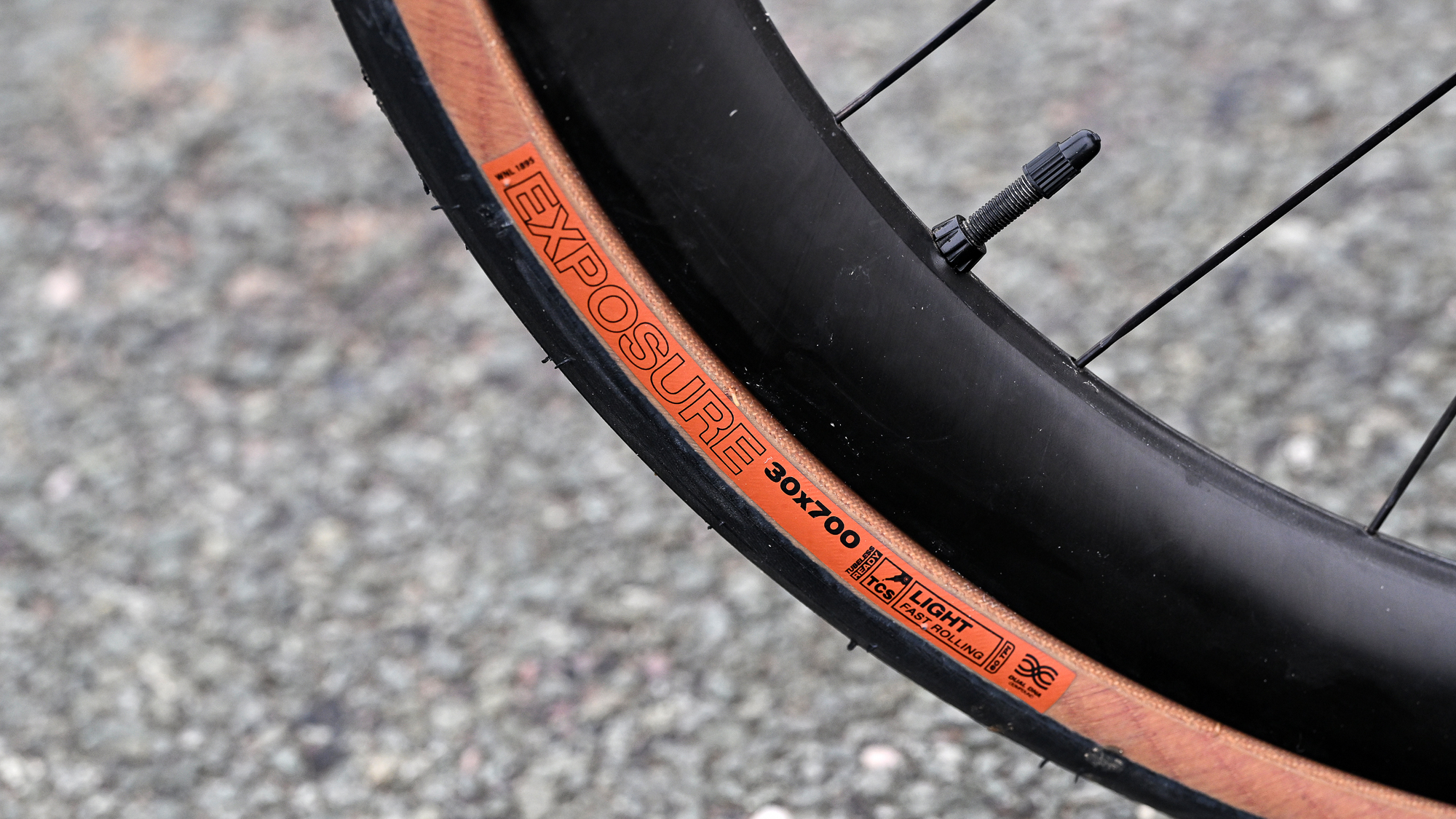 WTB Exposure TCS - a 'fast adventure road tyre'
WTB Exposure TCS - a 'fast adventure road tyre'The WTB Exposure TCS tyre offers an enticing combination of comfort, speed and durability aimed at pretty much everyone except racers
By Tim Russon Published
